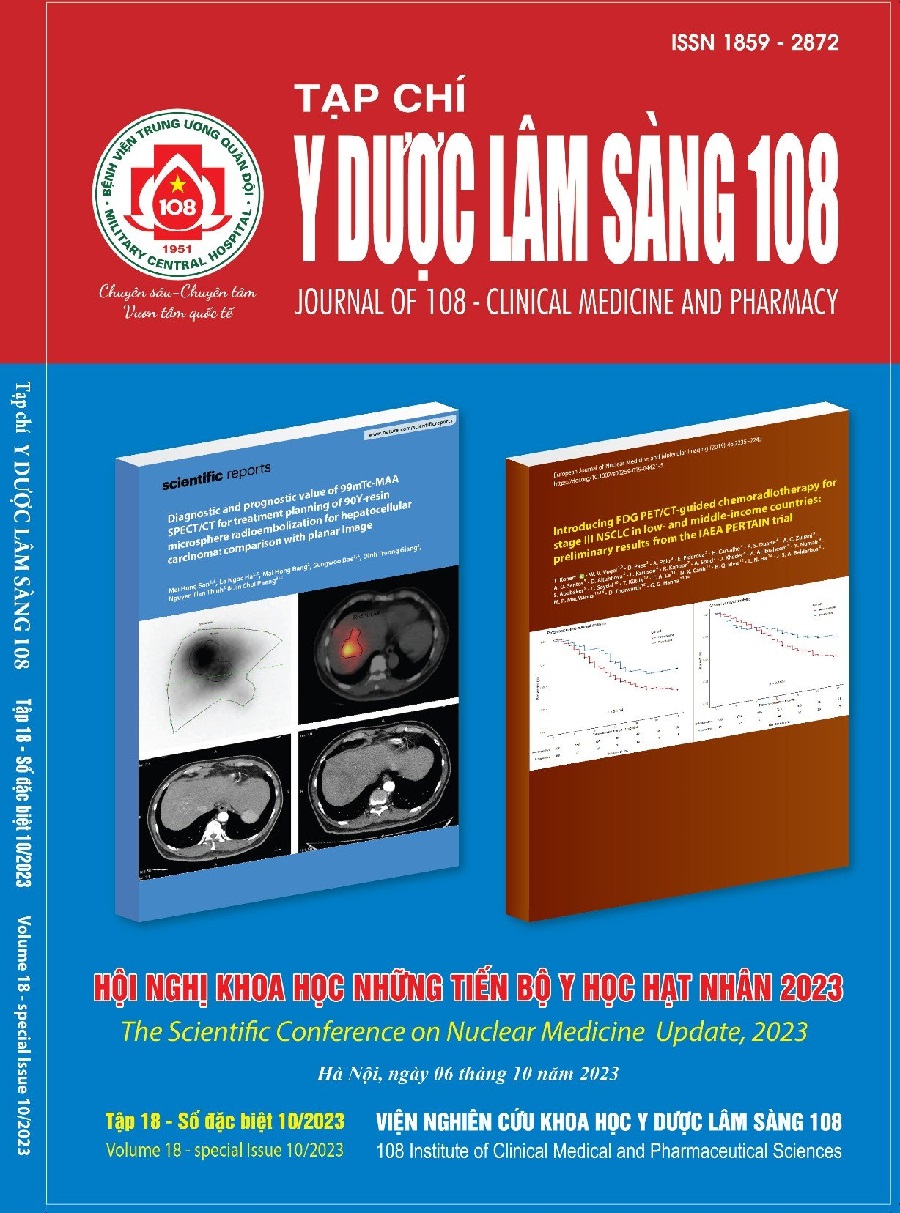The additional value of quantitative liver-lung shunt fraction on 99mTc-MAA SPECT/CT treatment planning before selective internal radiation therapy of liver cancer using CNN-based segmentation: Comparison with commercial software
Main Article Content
Keywords
Abstract
Objective: To estimate the liver-lung shunt fraction (LSF) in 99mTc-MAA SPECT/CT images using the CNN-based segmentation method. Subject and method: 34 consecutive HCC patients underwent CNN-based segmentation to assess liver lung shunt fraction, along with the corresponding with experienced nuclear medicine doctors using commercial software. The CNN-based segmentation method was developed by Hanoi Technology Institute. Result: 91.2% of male patients with mean age ± SD: 63 ± 13.3. Patients older than 60 years old were 64.7%. Most of the tumors were located on the right liver. There were 67.3% and 73.5% tumors with necrosis and heterogenous uptake of MAA respectively. Liver lung shunt was 5.4 ± 3.9% estimated by commercial software which was not a significant difference from CNN based method (p=0.058). The median time to perform a quantitative assessment using an automated CNN-based method was 1.05 minutes lower than 17.5 minutes using commercial software (p<0.05). The agreement between using the automated CNN-based method and the manual method using commercial software was moderate (Kappa = 0.62). Gastric and spleen were the organs defined wrongly by the automated method of segmentation. Conclusion: Automated CNN-based method seems to be a useful tool in assisting doctors to estimate liver lung shunt fraction. In addition, the CNN based method shortened the time for doctors to assess quantitative liver lung shunt.
Article Details
References
2. Nguyễn Trường Sơn, Lương Ngọc Khuê, Mai Trọng Khoa (2023) Hướng dẫn chẩn đoán và điều trị ung thư biểu mô tế bào gan. Bộ Y tế (3129/QĐ-BYT).
3. Kemeny NE, Chou JF, Boucher TM, Capanu M, DeMatteo RP, Jarnagin WR et al (2016) Updated long-term survival for patients with metastatic colorectal cancer treated with liver resection followed by hepatic arterial infusion and systemic chemotherapy. 113(5): 477-84.
4. Giammarile F, Bodei L, Chiesa C, Flux G, Forrer F, Kraeber-Bodere F et al (2011) EANM procedure guideline for the treatment of liver cancer and liver metastases with intra-arterial radioactive compounds. European journal of nuclear medicine and molecular imaging 38(7): 1393-406.
5. Luu MH, Mai HS, Pham XL, Le QA, Le QK, Walsum TV et al (2023) Quantification of liver-Lung shunt fraction on 3D SPECT/CT images for selective internal radiation therapy of liver cancer using CNN-based segmentations and non-rigid registration. Computer methods and programs in biomedicine 233: 107453.
6. Son MH, Ha LN, Bang MH, Bae S, Giang DT, Thinh NT et al (2021) Diagnostic and prognostic value of 99mTc-MAA SPECT/CT for treatment planning of 90Y-resin microsphere radioembolization for hepatocellular carcinoma: Comparison with planar image. Scientific Reports 11(1): 3207.
7. Chaichana A, Frey EC, Teyateeti A, Rhoongsittichai K, Tocharoenchai C, Pusuwan P et al (2021) Automated segmentation of lung, liver, and liver tumors from Tc-99m MAA SPECT/CT images for Y-90 radioembolization using convolutional neural networks. Medical physics 48(12): 7877-7890.
 ISSN: 1859 - 2872
ISSN: 1859 - 2872
